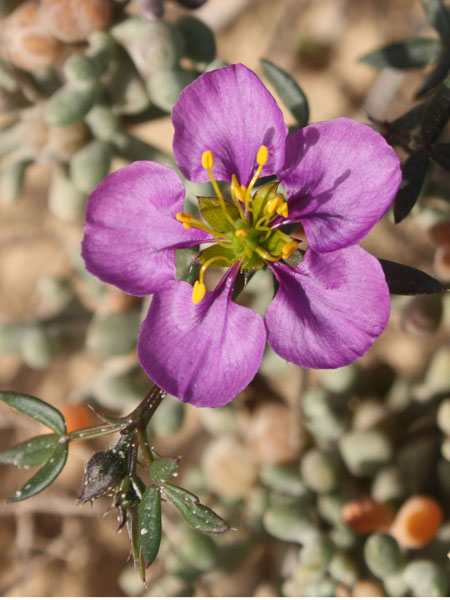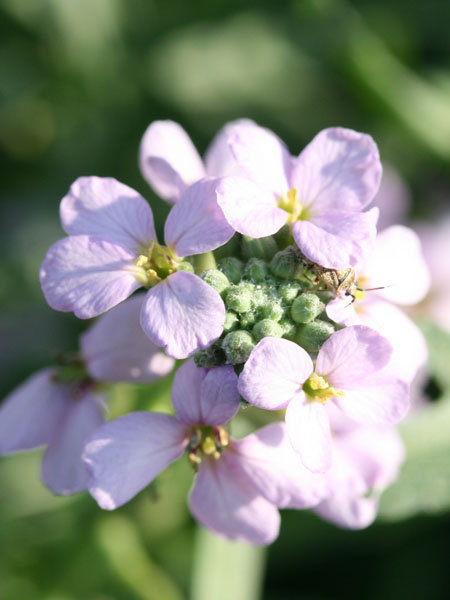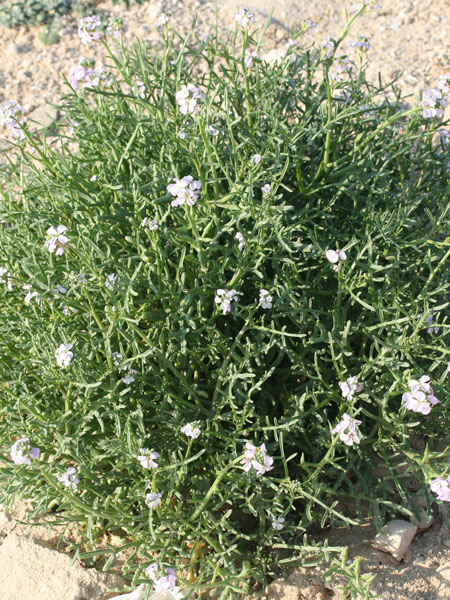Nitraria retusa
Kingdom : Plantae / النّباتات
Division : Spermaphyta / البذريات
Clade : Magnoliophyta or Angiospermae / مستورات البذور
Class : Eudicotyledoneae / ذات الفلقتين
Order : Sapindales / رتبة الصّابونيات
Family : Nitrariaceae / الفصيلة الغَرْقَدِيَّة
Genus : Nitraria
species : retusa
Chromosomes: 2n=24
Protologue
(Forssk.) Asch., Verh. Bot. Vereins Prov. Brandenb. 18: 94 (1876).
Synonyms
Peganum retusum Forssk., Fl. Aegypt.-Arab. LXVI, 221 (1775). Nitraria tridentata Desf., Fl. Atlant. 1: 372 (1798).
Common names
Tunisia Arabic English French Tamazight
الغردق
غرقد كليل
الغرقد
Nitraire à feuilles rétuses
Toxic
no
Edible
yes
Latex
no
Botanic description
Genus description
"The only genus of this family
Species description
"Spiny Shrub (0.50 to 1.50 m).
Stems thorny twigs Leaves cuneiform whole, or bearing teeth at their apical end, a little fleshy, stipulated. Flowers in small panicles corymbiform ending short branches: petals 5. whitish, hispid. Lamines 15, 3-cellous ovary. Inflorescence Corymbiform panicles Fruits drupe with a single seed developed.
Botanic References
Pottier-Alapetite G. (1981). Flore de la Tunisie Angiospermes –Dicotylédones (Apétales- Dialypétale , Première partie). Imprimerie Officielle de la République Tunisienne (Eds), 456p. Edouard LE FLOC’H, Loutfy BOULOS et Errol VELA. (2010). Catalogue synonymique commenté de la FLORE DE TUNISIE. République Tunisienne, Ministère de l’Environnement et du développement durable, Banque Nationale de Gènes. 500 p www.tela-botanica.org www.theplantlist.org
Biology
Life form Perennial Type form Nanophanerophyte Photosynthesis C3
Phenology
Blooming
JanuaryFebruaryMarchAprilMayJuneJulyAugustSeptemberOctoberNovemberDecember
Fruiting
JanuaryFebruaryMarchAprilMayJuneJulyAugustSeptemberOctoberNovemberDecember
Map Localization
Ecology
Adaptation Desert sands, more or less salty. Salt bladder yes Invasive no
Geographical distribution
Localization Biocimatic stage Annuel pluviometry (mm) GPS Djerba (Mellita, Déc.2013) Higher arid 209 33°51'40.76"N / 10°47'37.34"E Monastir (Sidi Ghedamssi Août 2016) Inferior semi-arid 331 35°46'55.54"N / 10°50'2.18"E
General uses
Edible red fruits.
Medicinal uses
"The ashes of Nitraria retusa have the property to heal infected wounds. Sweet-flavored drupes are edible for the treatment of hypertension. The melting and decoction of the leaves are used as tea or poultice for their anti-inflammatory properties.
NOTE : This website is not that of herbal medicine and assumes no responsibility for the negative effects of the use of plants. Seek advice from a professional before using a medicinal plant.
Systems / Organs / Effects
Digestive System Reproductive System Antiinflammatory Hypolipedemic Hypoglycemic Liver
Dispersion mode
- Barochore (gravity)
Germination
Duration
Image
Description of the seeds
Form External structure Ornamentation Type of seed Average length of 10 seeds ±(mm) Average width of 10 seeds ± (mm) Average thickness of 10 seeds ± (mm) Average mass of 100 seeds (g)
Test results
TPC DPPH ABTS+ FRAP Year mg GAE g-1 MS CI50 g ml-1 CI50 g ml-1 CE50 g ml-1 10,12± 0,82 191,26± 5,69 273,87± 3,60 815,34± 33,82 2016 Total Phenols content(TPC), Anti-radical potentialities against (DPPH, ABTS), Ferric reducing antioxidant power(FRAP)
Molecules : ADN / Proteins
Chromosomes : 24 Uniprot NCBI
Tunisian references
Boukef M.K. (1986). Les plantes dans la médecine traditionnelle tunisienne. Boubaker,J., Ben Sghaier, M., Ines, S., Ghedira, K., and Chekir-Ghedira L. (2012). “Isorhamnetin 3-O-robinobioside from Nitraria retusa leaves enhance antioxidant and antigenotoxic activity in human chronic myelogenous leukemia cell line K562,” BMC Complementary and Alternative Medicine, no. 12, p. 135. Médecine traditionnelle et pharmacopée. Librairie Larose (Eds), paris, 350p. Boubaker, J., Skandrani, I., Bouhlel I. et al. (2010). “Mutagenic, antimutagenic and antioxidant potency of leaf extracts from Nitraria retusa,”FoodandChemical Toxicology, vol. 48,no. 8-9, pp. 2283–2290. Zar Kalai F, Han J, Ksouri R, El Omri A, Abdelly C, Isoda H.(2013) Antiobesity Effects of an Edible Halophyte Nitraria retusa Forssk in 3T3-L1 Preadipocyte Differentiation and in C57B6J/L Mice Fed a High Fat Diet-Induced Obesity Hindawi Publishing Corporation Evidence-Based Complementary and Alternative Medicine Volume. Article ID 368658, 11 pages http://dx.doi.org/10.1155/2013/368658
Other references
El-Alali, A., Alzoubi, A., Gharaibeh, M., Tawaha, K., and Alali, F.Q.(2012). “Phytochemical and biological investigation of Nitraria retusa asch,” Jordan Journal of Pharmaceutical Sciences, vol. 5,no. 2. le Floc’h, E. (1952) Contribution a une étude Ethnobotanique de la Flore tunisienne, Ministère de l enseignement Supérieure et de la Recherche Scientifique.











